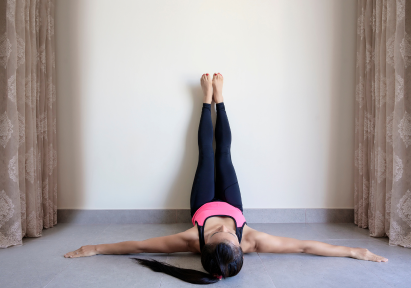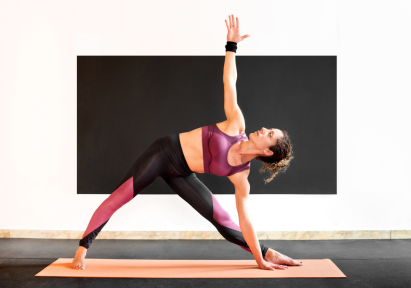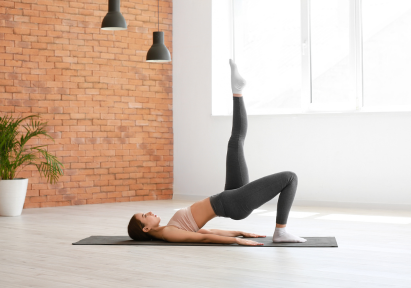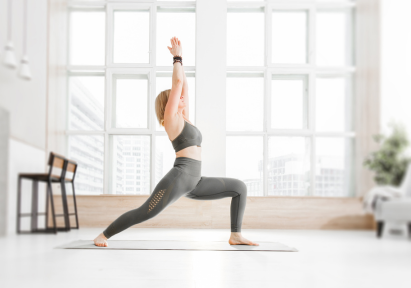



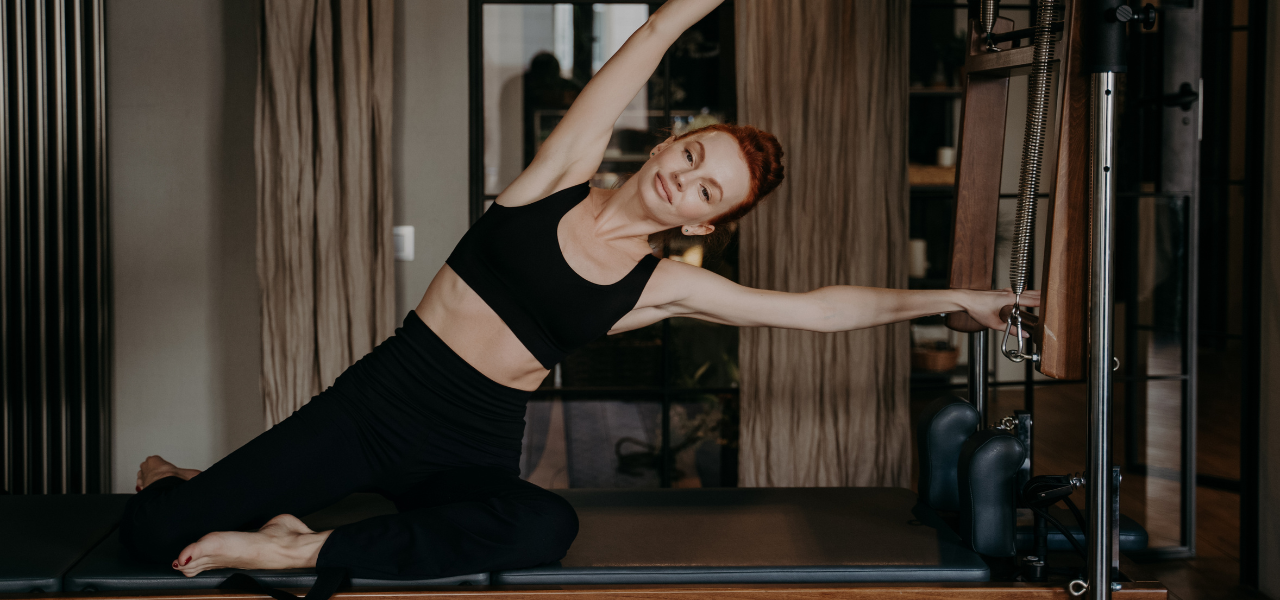
Are you looking for a gentle but effective exercise practice that will help you reach your fitness goals without making you throw up? Pilates workout might just be what you need. In recent years, fitness trends such as HIIT, functional training (think F45, CrossFit), and now Pilates have taken the fitness world by storm.
Having tried all these trends myself, I can see why there’s a huge hype around it. I could see myself progressing with every session. Each session has brought noticeable progress, from improved core strength to enhanced balance. It’s been incredibly rewarding.
Let’s take a look at what pilates is and what makes it special.
What Is Pilates?
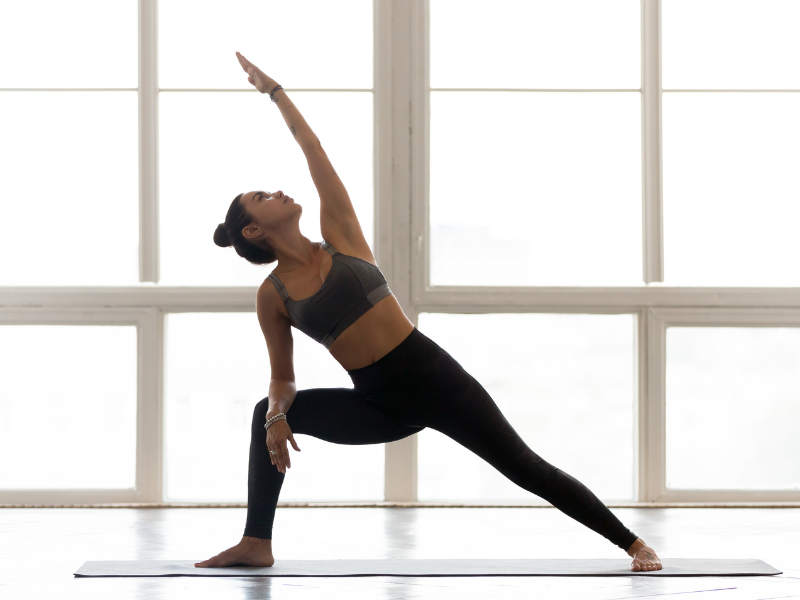
Pilates is a form of exercise and body conditioning that combines over 50 simple and repetitive exercises to strengthen and lengthen the muscles. Depending on how you do it, it can be used as a gentle strength training method for rehabilitation or adapted into a challenging workout.
History of Pilates
Born near Dusseldorf in 1880, Joseph Pilates was a sickly child who experienced asthma and rickets. As a result, he became determined to enhance his health and strength through exercise, immersing himself in gymnastics, bodybuilding, and martial arts at a young age [1].
When World War 1 erupted, Joseph, living in London at the time, was interned by British authorities on suspicion of being a spy. He was sent to an internment camp on the Isle of Man with others like him [1].
Joseph began developing the Pilates method, aimed at helping fellow inmates maintain physical fitness and recover through rehabilitation.
What makes Pilates so unique?
Unlike other workouts, Pilates focuses a lot on improving core strength so you’ll notice a number of Pilates core exercises being integrated in one session. A strong core is seen as essential for effectively performing exercises that engage other muscle groups.
The coaching style of Pilates focuses mainly on mind-body integration, being aware of the muscles that you are working in each movement, and breath regulation. You are strengthening the muscles and reducing stress levels.
You’ll know the workout is effective when you leave feeling stronger and more energized.
Types of Pilates
One great aspect of Pilates is how versatile it can be. It can come in various styles and approaches, catering to different fitness levels and goals. Here are the main types of pilates:
Mat Pilates
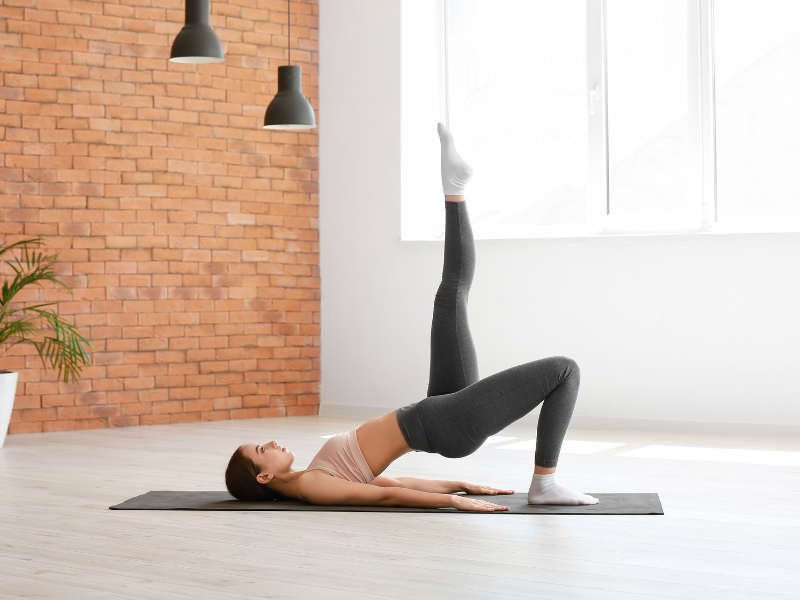
Mat Pilates is usually performed with a mat on the floor. It is an effective way to build and maintain muscle strength without the need for any equipment. You are constantly using only your body weight as resistance throughout the different exercise sequences.
Mat Pilates makes a great at-home workout option for those who may not want to spend too much on a gym membership or equipment. It is also great for remote employees or busy parents who need a quick workout at home.
Reformer Pilates

Reformer Pilates is done using a specialized machine with springs and a moving carriage, known as a reformer. It is a dynamic workout option as you can target various muscle groups simultaneously by combining the straps or other equipment.
The main form of resistance comes from the springs attached to the machine, unlike Mat Pilates. These springs provide adjustable resistance for different workouts.
Reformer Pilates can be adjusted to suit those with injuries or pregnant women.
Clinical Pilates
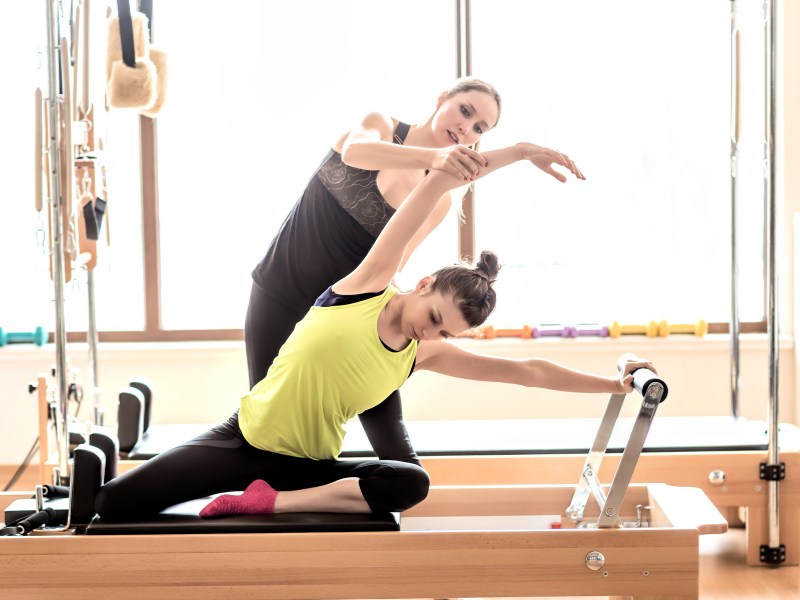
Clinical Pilates may look similar to reformer Pilates but it is tailored specifically to address injuries. It is a form of rehabilitation and physical therapy, conducted only by qualified physiotherapists with a certification to teach Pilates [2].
With the physiotherapist’s knowledge, you can expect to perform movements that integrate rehabilitation principles for recovery. As such, this is a suitable option for those who may have special requirements or specific injuries.
Classical Pilates
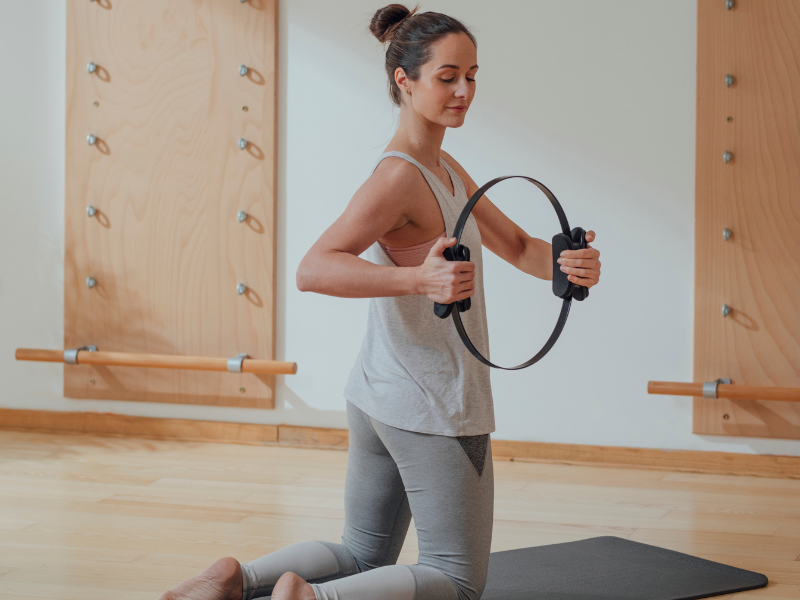
Classical Pilates is a form that sticks close to the original exercises and sequences developed by Joseph Pilates. The emphasis is on precision and control of the movements, preserving the traditional method.
It’s a system that progresses from foundational exercises to more complex ones, designed to move the body through its full range of motion. It not only incorporates the Reformer but also integrates other equipment like the Cadillac, Wunda Chair, Barrel, and more [3].
It is great for those who are looking for a structured and traditional approach to Pilates.
Contemporary Pilates
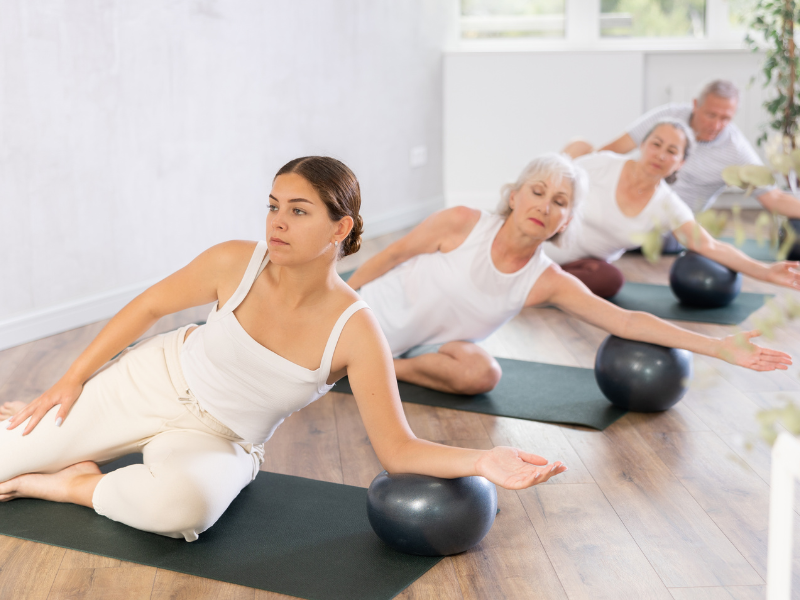
Contemporary Pilates fuses traditional Pilates with a modern twist. It incorporates modern fitness equipment (e.g. resistance bands and balls) and techniques for a different experience. You may find that it has elements of strength training and cardio for a well-rounded workout.
This can be great for those who are looking for a more modern approach. It can also be great for those with a limited range of motion and are looking to improve their functional movements.
Equipment Used In Pilates
Some of the common equipment used in Pilates includes:
- Yoga mat or exercise mat
- Magic circle or Pilates ring
- Resistance bands
- Reformer machine
- Cadillac
- Wunda chair
- Barrel
- Foam roller
- Stability ball
Health Benefits of Pilates
Despite being low-impact, Pilates offers numerous health benefits, including [4]:
- Improves core strength: As the exercises largely emphasize working the core muscles and pelvic floor, it leads to better stability and strength.
- Increases flexibility: Regularly practicing Pilates can help to improve overall flexibility and range of motion. This is especially important for reducing the risk of injuries.
- Improves posture: The exercises promote the awareness of proper alignment of the spine and neck. Thus, correcting poor posture and alleviating pain.
- Improves balance and coordination: Some exercises involve more than one muscle group, challenging balance and coordination skills. Doing it regularly will help to improve these skills.
- Aids weight loss: Pilates may also help you to build lean muscle mass, increase metabolism, and maintain a healthy weight.
Is Pilates a good way to lose weight?
“Weight loss is determined by your total energy expenditure and requires you to be in a caloric deficit–which means you’re burning more calories than you consume. Because of that, while exercise is important, your diet is the most important factor that will determine your weight loss.
With that said, however, you do need to stay active and find activities you enjoy. So if you love Pilates and it’s a form of exercise you can do consistently, then yes, it can be a part of your weight loss regimen.” — Meg Lambrych, BSN, RN, NASM-PT, PN-1
Common Pilates Exercises
Pilates places a strong emphasis on enhancing core strength. Therefore, you can expect to perform common core exercises such as planks, crunches, and leg raises to target and strengthen your core muscles.
A strong core is essential to helping you prevent bodily injuries, and enhance balance and stability such that you will be able to perform the basic daily activities smoothly. Think about bending, lifting, pushing, bathing or even putting your shirt on.
Some other common exercises are:
- Single Leg Stretch
- Leg Circles
- The Hundred
- All Fours
- Shoulder Bridge
How To Start Pilates
I know how exciting yet scary it can be to get started on a new workout routine. It’s the initial fear of not knowing what to do and not wanting to embarrass yourself in front of others.
Not to worry, here is a step-by-step guide to help you get ready for your first session:
- Identifying your goals: Identifying what you want to achieve before starting a new workout is important. That way, you have a source of motivation.
- Assess your fitness level: Understanding your fitness level will allow you to decide whether you should be doing a beginner, intermediate, or advanced workout sequence. To assess your fitness level, refer to this: Fitness level assessment.
- Choose a class: Based on your fitness level, choose the type that you find most appropriate. E.g. Clinical pilates if you have physical injuries, Mat pilates for beginner level, etc.
- Finding a certified Pilates professional: If you decide to attend a Pilates class, look for certified instructors with experience and positive reviews for a good first experience. Otherwise, YouTube is a great place to start for your first at-home pilates workout.
- Start slowly and progress gradually: You want to ensure that you start with the basics and progress with time. Don’t be quick to rush into an advanced level without building your foundation.
By following these steps, you can ensure that your first time will be a pleasant experience. Who knows, it may even inspire you to keep up with this practice!
Is 20 minutes of Pilates a day good enough?
“We all have different fitness levels, health goals, lifestyles, and schedules. Your specific exercise goals will be based on your personal needs, preferences, and health needs, so 20 minutes of Pilates may be ambitious for one person, and wholly inadequate for another.
No matter what your current fitness level is, you should start slowly and build gradually to prevent injury or overwhelming muscle soreness that can discourage you and halt your progress. If you are completely new to exercise, work with a fitness professional who can assess your fitness level and help you create measurable, attainable fitness goals.” — Meg Lambrych, BSN, RN, NASM-PT, PN-1
Other Tips For an Effective Workout
To maximize the benefits of your Pilates practice and ensure a productive workout, you may want to consider implementing these tips:
- Focus on your breathing pattern: Practice deep breathing and ensure that you are coordinating your breaths with your movements. Avoid holding your breath.
- Engage your core muscles: Try to always keep your core muscles engaged to keep your spine stabilized and in a neutral position. Your core should feel tense and stiff when you are engaging it. You should also feel stable from your spine to your pelvis.
- Move with control: Ensure that your movements are always slow and steady. You should feel the muscle engagement in the target areas with each movement.
- Listen to your body: If you need to take breaks, take them. Avoid pushing your body too much to prevent strains or injuries.
Free Pilates Workouts By JustFit
Here are some free workout videos to help you get started on your Pilates journey. All of these workouts can be done at home and are suitable for beginners.
Conclusion
Overall, Pilates is a versatile and effective workout that caters to a wide range of fitness levels and goals. It helps you to improve your core strength, improve posture, and increase flexibility and balance, all of which are important to prevent injury and help you perform basic activities.
If you are looking for a way to get started, you can start with short at-home Pilates workout. The JustFit app provides some quick and easy pilates workouts suitable for beginners to advanced levels or for those who are busy. Try it now for free.
What kind of workout is Pilates?
Is 30 minutes of Pilates enough exercise?
BetterHealth (2022) Pilates - health benefits [online]. Available at: https://www.betterhealth.vic.gov.au/pilates-health-benefits
Edge Healthcare (2023) CLINICAL PILATES VS TRADITIONAL PILATES: UNDERSTANDING THE KEY DIFFERENCES [online]. Available at: https://www.edgehealthcare.com.sg/clinical-pilates-vs-traditional-pilates-understanding-the-key-differences/
March, Bridget (2019) Classical Pilates: how it differs to modern forms of Pilates (and why celebrities still love it) [online]. Available at: https://www.harpersbazaar.com/uk/beauty/fitness-wellbeing/a26342380/classical-pilates/
The Knockaloe Charitable Trust (n.d.) Joseph Pilates [online]. Available at: https://www.knockaloe.im/profile_428812.html

